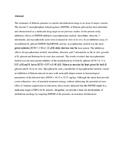Mycophenolic Acid, Mycophenolate Mofetil, Mizoribine, Ribavirin, and 7-Nitroindole Inhibit Propagation of Babesia Parasites by Targeting Inosine 5'-Monophosphate Dehydrogenase

View/
Date
2014Author
Xuan, Xuenan
Nishikawa, Yoshifumi
Igarashi, Ikuo
Masatani, Tatsunori
Moumouni, Paul Franck Adjou
Kamyingkird, Ketsarin
Zhou, Mo
Terkawi, Mohamad Alaa
Aboge, Gabriel Oluga
Cao, Shinuo
Language
enMetadata
Show full item recordAbstract
The resistance of Babesia parasites to current anti-babesiosis drugs is an issue of major concern. The inosine 5'-monophosphate dehydrogenase (IMPDH) of Babesia gibsoni has been identified and characterized as a molecular drug target in our previous studies. In the present study, inhibitory effects of IMPDH inhibitors (mycophenolate mofetil, mizoribine, ribavirin, 7-nitroindole, and mycophenolic acid) were evaluated in vitro or in vivo. In an inhibition assay of recombinant B. gibsoni IMPDH (BgIMPDH) activity, mycophenolate mofetil was the most potent inhibitor (IC50 = 2.58 ± 1.32 μM) while ribavirin was the least potent. The inhibitory effects of mycophenolate mofetil, mizoribine, ribavirin, and 7-nitroindole on the in vitro growths of B. gibsoni and Babesia bovis were also assessed. The results revealed that mycophenolate mofetil was the most potent inhibitor of the multiplications of both B. gibsoni (IC50 = 0.13 ± 0.05 μM) and B. bovis (IC50 = 0.97 ± 0.49 μM). Ribavirin was also the least potent for both B. gibsoni and B. bovis in vitro. Mycophenolic acid, a metabolite of mycophenolate mofetil, caused an inhibition of Babesia microti in mice with noticeable improvement in hematological parameters of the infected mice (ED50 = 44.15 ± 12.53 mg/kg). Although the report here provide a non-exhaustive view of potential treatment strategy without addressing the potential adverse effect of immune suppression on infections, these results indicated that the IMPDH might be a molecular target of MPA for B. microti. Altogether, we provide a basis for development of antibabesia prodrugs by targeting IMPDH of the parasites in treatment of babesiosis.
